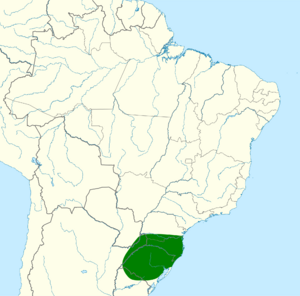Long-tufted screech owl facts for kids
Quick facts for kids Long-tufted screech owl |
|
|---|---|
 |
|
| Long-tufted screech owl at Urupema, Santa Catarina (state), Brazil | |
| Conservation status | |
| Scientific classification | |
| Genus: |
Megascops
|
| Species: |
sanctaecatarinae
|
 |
|
| Synonyms | |
|
Ephialtes argentina Schlegel, 1862 (disputed name) |
|
The long-tufted screech owl (Megascops sanctaecatarinae) is a type of "typical owl" found in parts of Argentina, Brazil, and Uruguay. This owl is known for the long tufts of feathers on its head, which look a bit like ears!
Contents
About the Long-Tufted Screech Owl's Name
The long-tufted screech owl has had a few different names over the years! It was first described by a scientist named Osbert Salvin in 1897. He gave it the scientific name Scops sanctae-catarinae. Over time, its name changed to Otus and then to its current name, Megascops.
Why the Name Changed
For a while, scientists thought this owl might be the same as the black-capped screech owl. They also wondered if it was related to the Yungas screech owl or the Middle American screech owl. But after studying their bodies, calls, and genes, scientists found that these owls are actually different species. They are not even closely related to each other.
The long-tufted screech owl is considered "monotypic." This means there are no different subspecies or types of this owl; it's just one distinct species.
What Does the Long-Tufted Screech Owl Look Like?
This owl is about 25 to 28 cm (9.8 to 11 in) long. Males usually weigh between 155 to 194 g (5.5 to 6.8 oz), and females are a bit heavier, weighing 174 to 211 g (6.1 to 7.4 oz). It's a fairly large and strong owl compared to other screech owls.
Color and Features
Long-tufted screech owls can come in three different colors: brown, gray, or rufous (reddish-brown). The brown color is the most common. The owl has very noticeable "ear" tufts on its head.
The common brown owl has dark brown feathers on its upper body. Its face is brown with a darker edge. Its belly has a mix of brown bars, streaks, and wavy patterns. Its eyes are pale yellow to orange-yellow, and its beak is greenish-gray.
Where Do Long-Tufted Screech Owls Live?
You can find the long-tufted screech owl in southeastern Brazil, specifically in the states of Paraná, Santa Catarina, and Rio Grande do Sul. They also live in the Misiones Province of northeastern Argentina and in northern Uruguay.
Preferred Habitat
These owls like to live in places that are open or partly open. This includes areas with scattered trees, pastures with trees, and the edges of dense forests. They also live in secondary forest (forests that have grown back after being cut down) and small groups of trees near villages. They usually live at elevations between 300 and 1,000 m (980 and 3,300 ft).
Long-Tufted Screech Owl Behavior
Movement and Daily Life
Scientists believe that the long-tufted screech owl stays in the same area all year round. It does not migrate. This owl is mostly active at night, which means it is a nocturnal animal.
What Do They Eat?
The long-tufted screech owl hunts by dropping down from a tree branch onto its prey. Its diet includes arthropods (like insects) and small animals with backbones. They are known to eat rodents, birds, amphibians (like frogs), and even fish!
Life Cycle and Reproduction
The breeding season for the long-tufted screech owl seems to be around August and September. These owls build their nests in holes in trees. These holes can be natural or made by woodpeckers.
From the few nests scientists have observed, one or two young owls usually hatch. It appears that only the female owl sits on the eggs to keep them warm. Not much else is known about how these owls raise their young.
How Do They Communicate?
The male long-tufted screech owl has a main song that sounds like a deep, fast trill. It lasts for about 5 to 10 seconds and stops suddenly. The female's song is similar but shorter and has a higher pitch.
The male also has a second song with short, fast notes that get longer and more spaced out. The female's second song is very different. It's a loud, rough, and unique "bababa..." sound that no other screech owl makes!
Conservation Status
The IUCN (International Union for Conservation of Nature) has listed the long-tufted screech owl as a species of "Least Concern." This means it is not currently considered to be in immediate danger of extinction.
However, even though it lives in a fairly large area, its total population size is not known. Scientists believe the number of these owls is decreasing. The biggest threats to the long-tufted screech owl are the loss of its habitat. This happens because of too much grazing by animals, fires, and trees being cut down.


